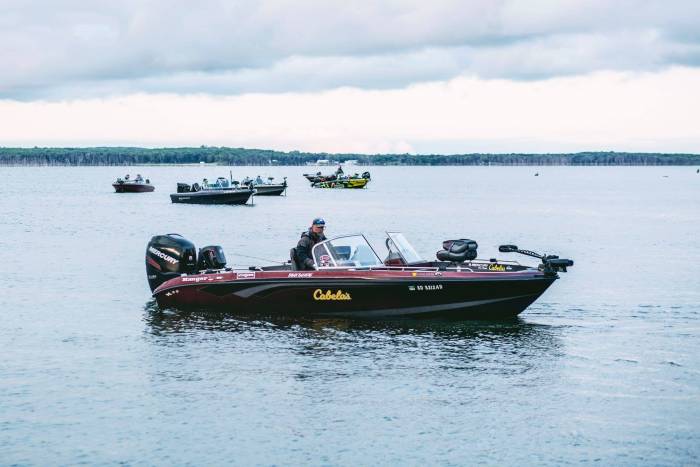A pro walleye angler explains three ways to catch walleyes as summer starts giving way to fall.
Brian Bashore, the owner of The Walleye Guys Guide Service in Yankton, S.D., knows a lot about catching walleyes. He earned his angling education guiding walleye anglers for 10 years and competing in walleye tournaments for 20.

As a member of the Cabela’s/Bass Pro pro-staff team, Bashore presents at least six in-store fishing seminars per year. We made a call to the walleye fishing expert to find tips for targeting this species. Here are three techniques Bashore uses to find and catch early-fall Midwest walleyes.
Trolling With Lead-Core Line for Fall Walleye

Where to Troll
Before water temperatures start dropping in late fall, walleyes continue to seek refuge in deeper, cooler water. They seek mud flats for their prey: the baitfish and perch that school there, eating insects. Bashore said big fish usually hold close to the mud bottom in this scenario.
When he finds fish on his sonar unit, Bashore uses a “bottom-up” approach. He lets line out to send the crankbait to the bottom, then reels up enough to prevent snagging. If fish are suspending, it’s best to reel up at least one rod to target them.
Walleyes might still be a bit lethargic in warm midday waters, but they still need to eat. An abundance of baitfish this time of year adds to the lethargy. Bashore is looking for a reaction bite as he puts the lures right in front of the fish.
Trolling speed isn’t a crucial consideration in early fall. Start in the 2.5- to 3-mph range when water temperatures are still in the 70s. Slow to 1.8 to 2 mph in deeper waters, or to give the crankbaits more action.
Recommended Trolling Gear
Bashore trolls 18-pound-test lead-core line ($24) with 10 feet of 15-pound fluorocarbon leader. Bashore suggests trying to match the hatch of baitfish and young gamefish in your area with small crankbaits. He likes the Salmo Hornet ($8), Berkley Flicker Shad ($6), and Rapala Jointed Shad Rap ($4.75 to $7.50) — all in 2-inch versions.
Fall Walleye Fishing: Targeting Weeds

Weeds: The Where and Why
Weeds present another great option for early-fall walleye fishing. Look near shorelines or weeds submerged in open water, which can offer angling action all day in early fall.
These weeds give ample cover for wary baitfish looking out for predators. The aquatic grass also provides ample oxygen and shades the sun, resulting in cooler water temps for fall walleye fishing.
Like deep, cool mudflats, weeds attract baitfish and the predators that follow them. The difference between the two? Walleyes located near weeds are shallow for one reason: to eat.
Bashore suggests casting crankbaits to work the edges and open pockets in surface weed beds. You can expect aggressive bites in these locations. Throw crankbaits or troll a crawler harness if you find submerged weeds in the open water.
Gear for Targeting Weeds
Look for crankbaits that produce aggressive actions, such as the Rapala Shad Dancer ($9) or Berkley Bad Shad ($7).
Bashore’s favorite trolling technique over weeds includes a Northland Baitfish Spinner Harness ($5.50), with a holographic baitfish blade. The blade’s flash attracts walleyes, which find a live or artificial nightcrawler at the end of the rig.
Switch to a Berkley Gulp! Alive! Spinner Crawler ($20) when perch or small walleyes steal live worms. Gulp! Baits stay on the hook better and offer added appeal with an infused attractant scent.
Fishing Glide Baits in Autumn

How to Use Glide Baits
First proved effective by ice anglers, glide baits attract and catch walleyes in open water too. They’re fish-shaped pieces of lead with a hook on each end, and a treble hook at the belly. Fish this technique in clear water. The fish need to see the quickly falling lure to find it.
Target fishing glide baits over the structure of rocks or trees. This is normally in water 10 to 40 feet deep. When fishing a hard bottom, let the lure hit bottom before ripping it upward with a hookset action.
The shape of the lure produces an erratic, darting action as it falls back to the bottom. Let the lure fall on a slack line. You might feel a strike, or see the line twitch, but most hookups occur on the following rip.
Glide Bait Gear
Bashore’s favorite glide baits include Rapala Jigging Rap ($8), Northland Tackle Puppet Minnow ($6), and Moonshine Shiver Minnow ($5.50). Depending on water depth, use baits weighing from 7/8 of an ounce to 1.5 ounces.
He chooses a St. Croix Eyecon Snap Jig Spinning Rod when fishing glide baits. These rods feature a soft tip for fighting fish with heavy lures in their mouths. And they sport the added backbone needed to handle the violent jigging action.
Bashore suggests using 8- to 10-pound Berkley Fire Line tied to a No. 14 barrel swivel to prevent line twist. He finishes the terminal end with 2 to 3 feet of 10- to 15-pound fluorocarbon line.
Thoughts From the Fall Boat Ramp
Stay versatile and don’t overlook shallow-water walleyes. They can be everywhere in the transition from late summer to early fall. Shallow waters with weed structure produce the numbers, but look deep if trophies are of interest.






